
Korean Pickles (Jangahjji 장아찌) can be made with cucumbers, garlic scapes, chili peppers, onions and even broccoli stems.
Pickles..pickles…so delicious, so crunchy, tangy, sweet, salty and even a hint of chili flavor it simply tastes divine. Summers are pretty hot in Korea and when it’s so hot, you often don’t have much of an appetite. But..get a bowl of ice cold water, put some rice (room temp) in it and eat the rice in water with these Korean pickles. Yum! This was a true summer time staple in the good old days.
So, I decided to make some Korean pickles or Jangahjji/Jangajji this summer, from a recipe I got from my mother-in-law during my last visit to Korea. BTW, there are many kinds of Jangajji – check here for a list. It was pretty simple and quite easy to do.
There are many different ingredients you can make pickle out of and here are a few very traditional and authentic ingredients : cucumbers, garlic, garlic scape(stems), onions, green chili peppers and radishes. Broccoli stems and chayote are some new ingredients that Korean Americans discovered and began to pickle very recently.
Depending on their flavors, you can mix various vegetables and pickle them in the same jar. Note that adding garlic or garlic stems will add a garlic flavor to the whole pickle jar so think about it before you mix garlic with other ingredients. I wanted to keep my cucumbers separate from the garlic so I made two jars – one with cucumbers and green peppers and another with garlic and garlic stems.
So here’s what I did:
Korean Pickles Recipe
Prep Time: 10 min Cooking Time: 10 min Pickling Time: 7 days
Ingredients for Korean cucumber pickles (오이 장아찌 Oyi Jangahjji)
- 4 Korean cucumbers (오이 Oyi) (Persian or Pickle cucumbers also OK)
- 5 green chili peppers (optional)
- 3 C soy sauce (approx)
- 3 C sugar (approx)
- 3 C rice vinegar (approx)
- handful of rough Korean sea salt
- glass jar for pickling (I reused a Kimchi jar)
Directions
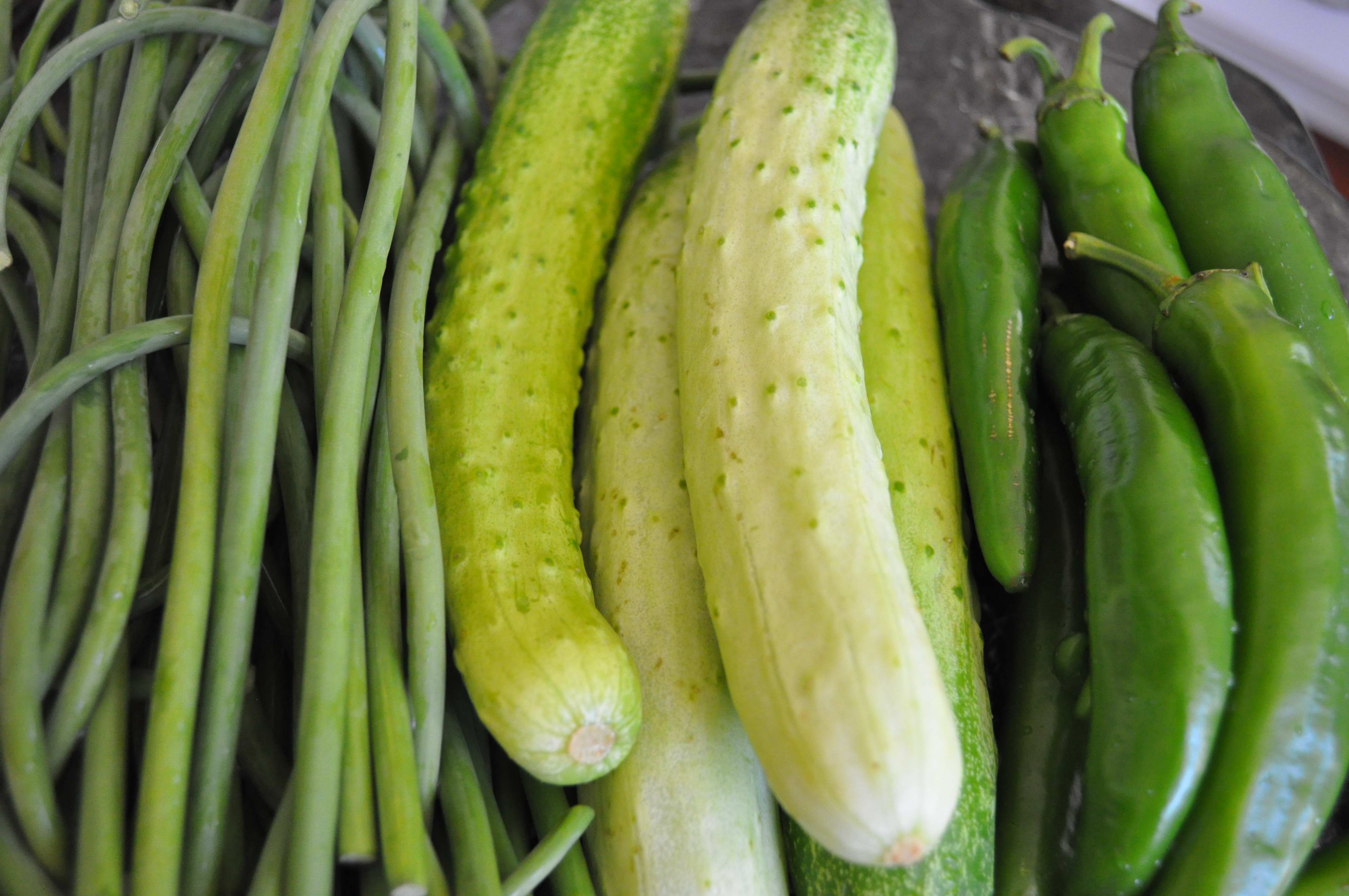
The amount of pickle juice needed varies based on the amount of ingredients and the size and shape of your glass jar. All of the vegetables must be totally submerged in liquid for them to be pickled properly without getting mushy. So the best way to determine how much pickling liquid you will need is to actually put the vegetables in the jar first, then pour enough water in the jar to totally cover all the vegetables. The amount of water poured is the amount of pickle juice you will need then measure the amount of water you used. Then you can calculate back from that how much pickle juice you will need to prepare. For the amount of cucumbers I had, I needed about 6 cups of liquid which then made me figure out that I needed 3 cups of soy sauce and vinegar each to make the 6 cups. The amount of sugar needed just follows the 1:1:1 ratio of soy sauce, vinegar and sugar.
1. Mix soy sauce, vinegar and sugar in a pot and let it come to a boil. When it boils, turn the heat off and let it sit.
2. In the mean time, grab a generous pinch of sea salt and clean the cucumbers by rubbing each one with salt. This is like giving the cucumbers a good exfoliating massage. 🙂 Rinse the cucumbers with water and pat them dry. You can then cut the cucumbers into bite size pieces or keep them whole. I like cutting them because it saves me the trouble of cutting them later. Traditionally, whole cucumbers are used – I have heard that it keeps the cucumbers crunchy longer.
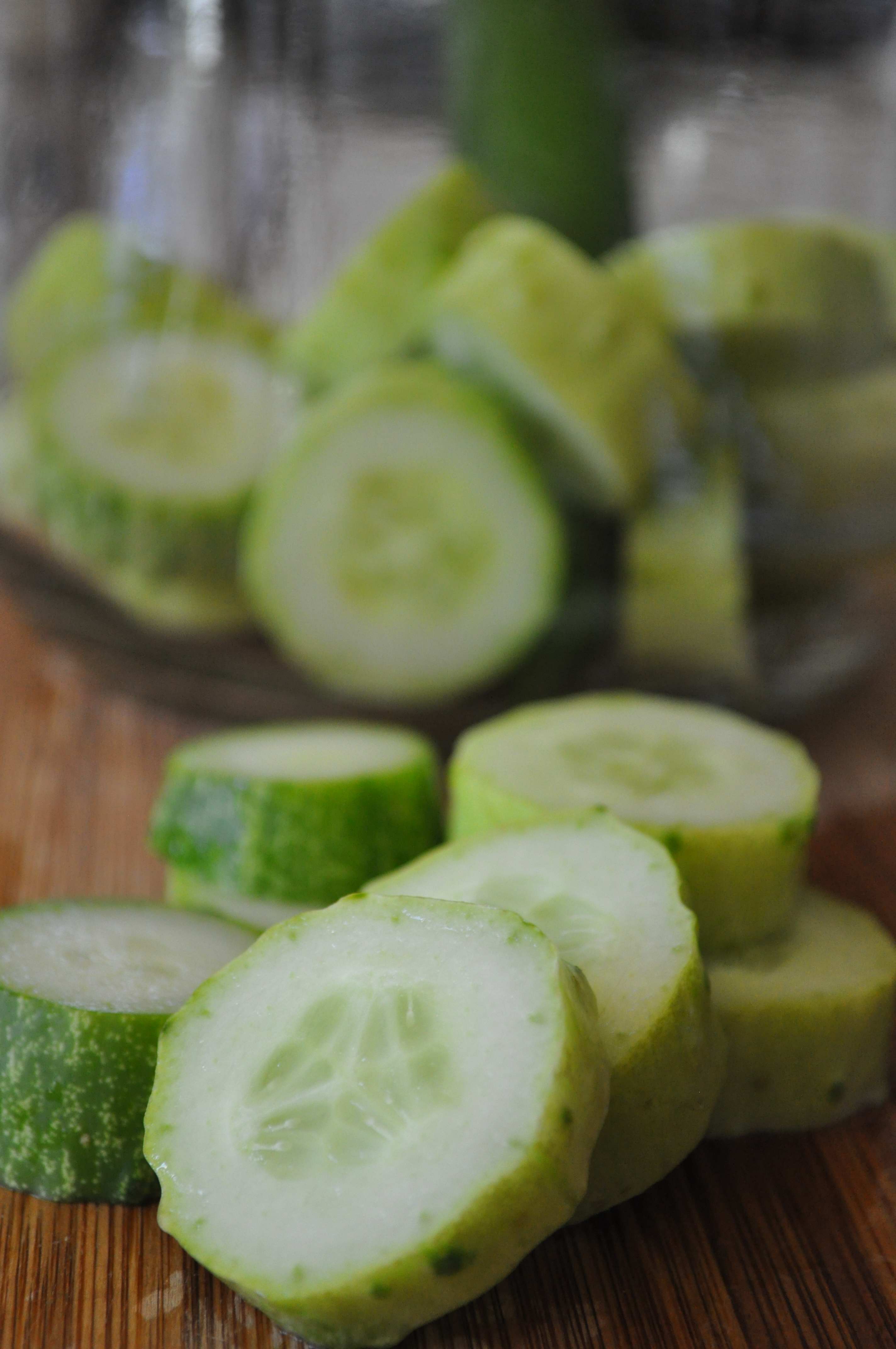
3. Wash the green chili peppers. Whole peppers can be used or can be cut into pieces. When using whole peppers, make a hole in the pepper by piercing it with a sharp skewer or toothpick. This helps the pickling juice to be evenly absorbed into the pepper. I like using Korean green chili peppers because they are not as spicy but you can also use Jalapeno peppers or other peppers. A good substitute for a Korean chili pepper is the Anaheim green chili pepper.
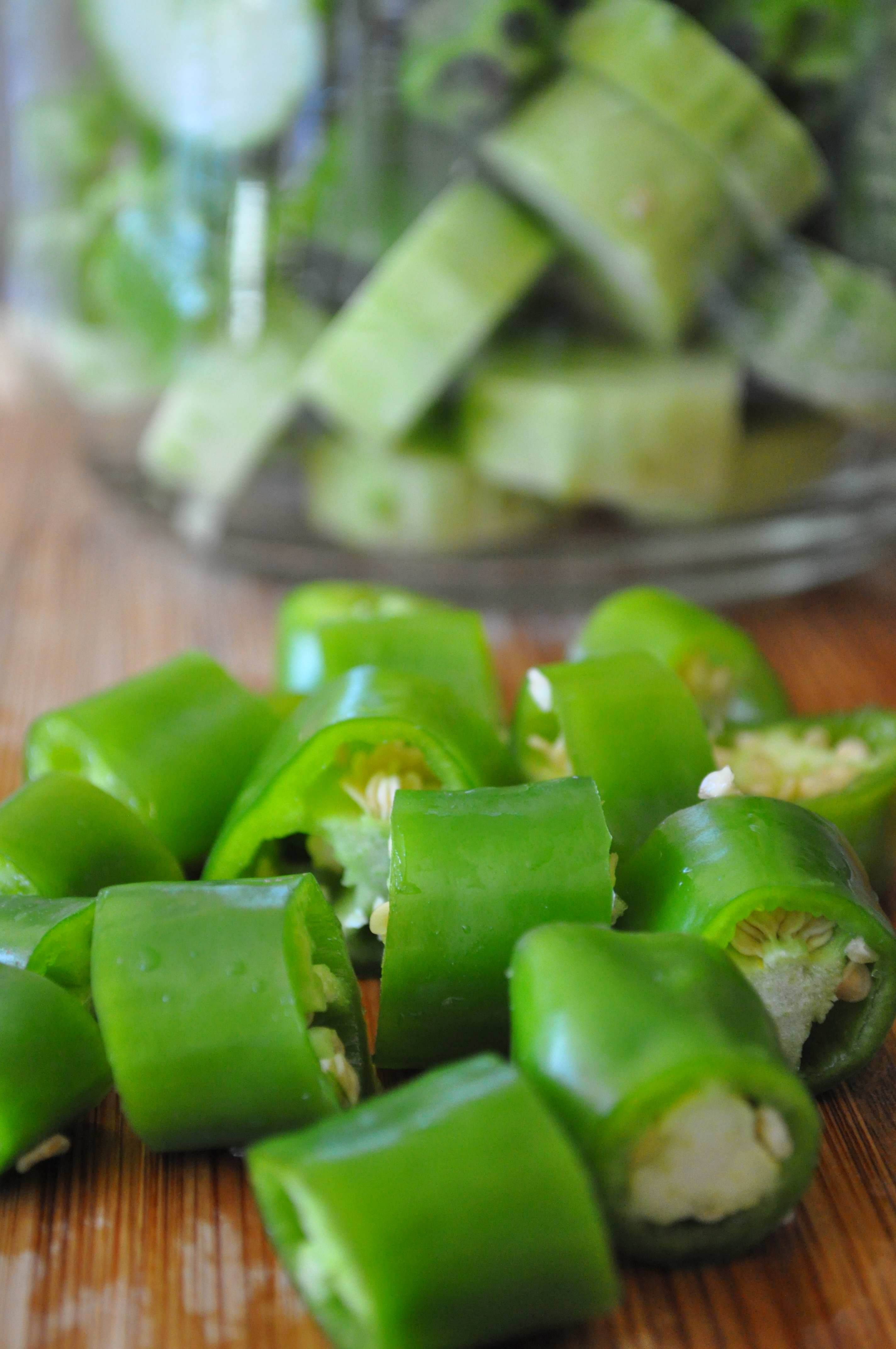
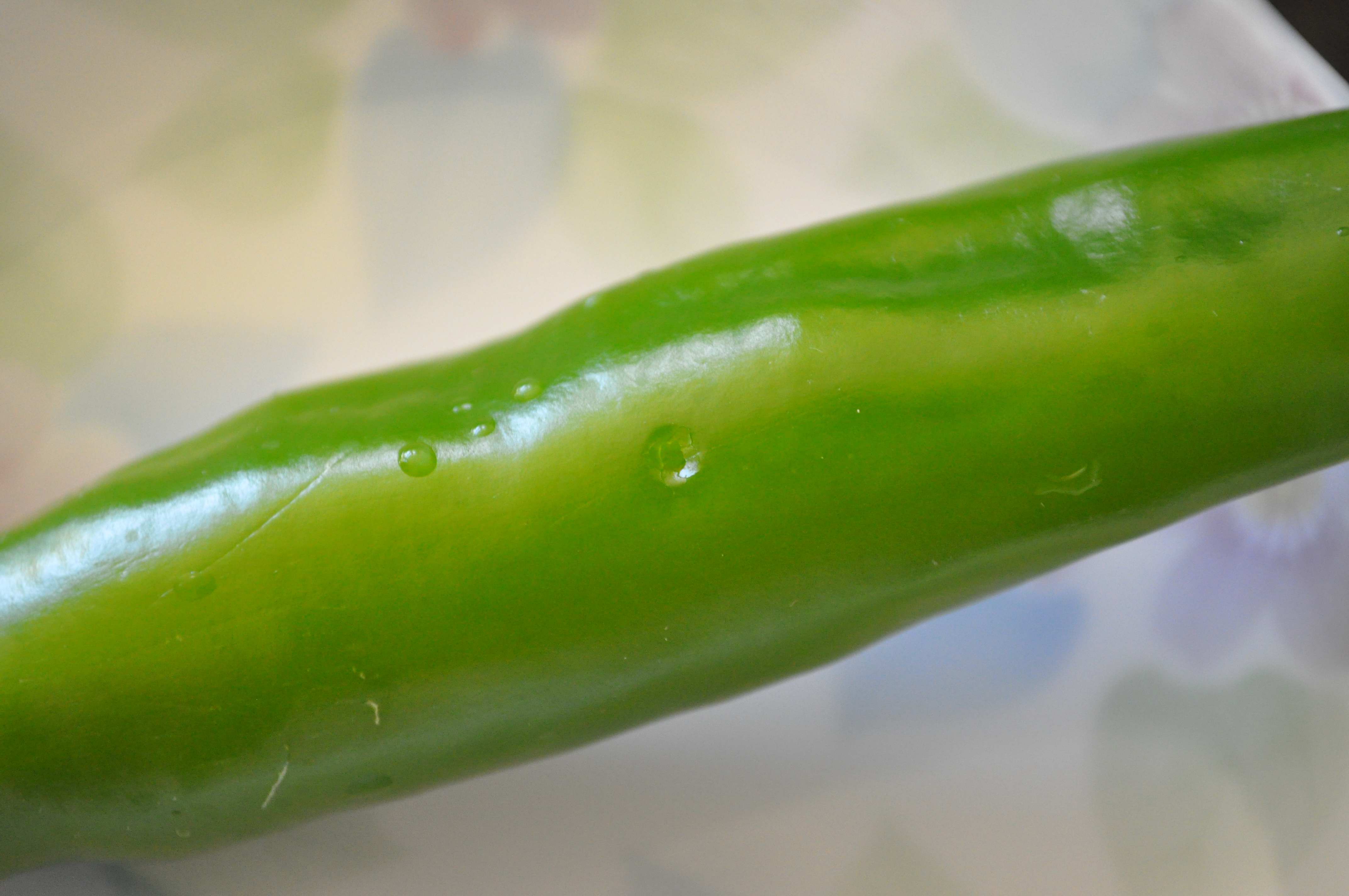
5. Put both the cucumbers and chili peppers into the jar. Now pour the soy sauce mixture onto the vegetables. The sauce should be quite hot – the hot temperature of the sauce shocks the vegetables and makes them crunchy so make sure it’s nice and hot!
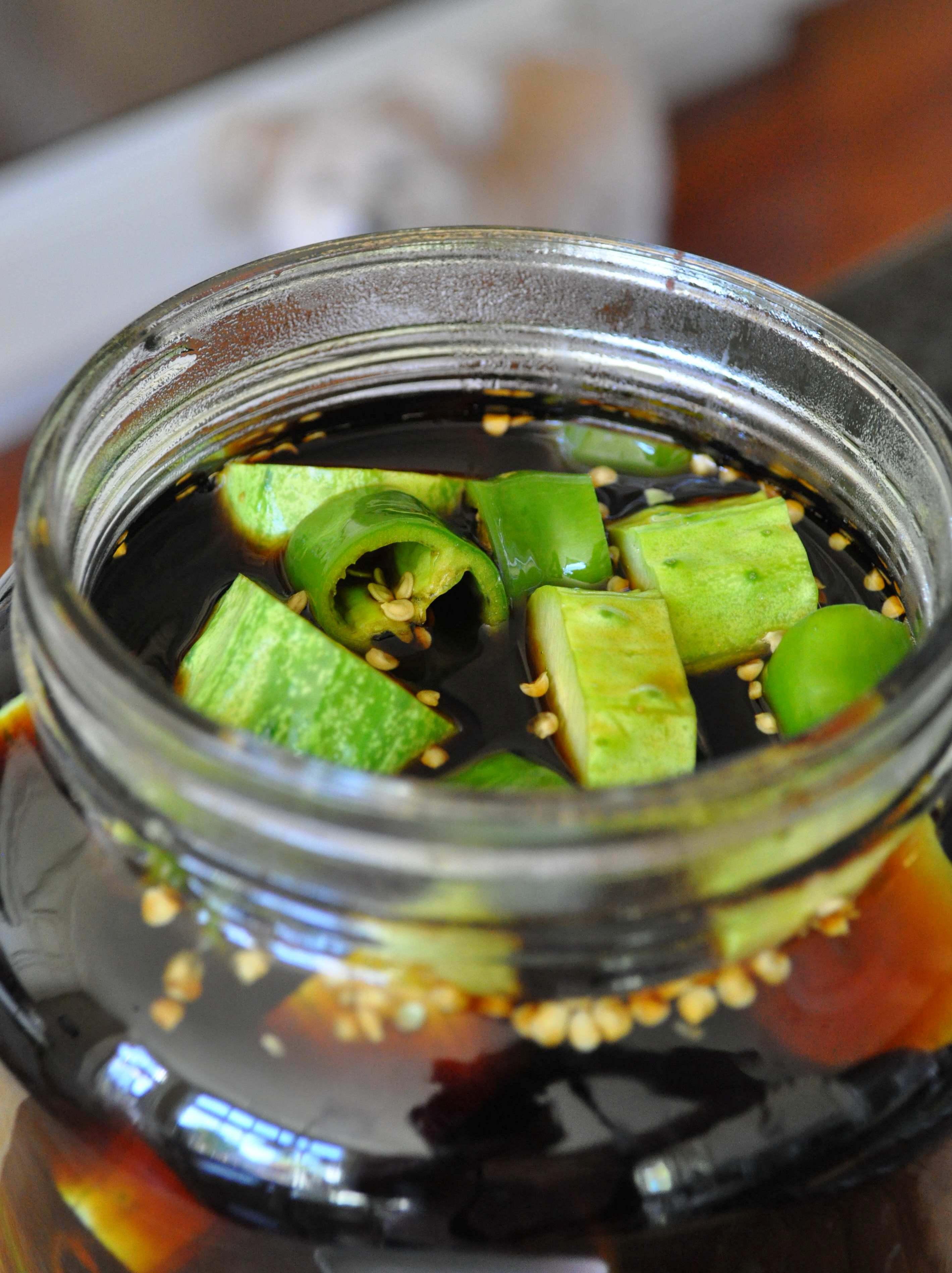
6. Just find something to weigh the vegetables down and you are almost done! When I was little I saw my mom use a stone to push everything down into the liquid. She would just get a clean smooth stone from the garden, then wash and boil it in water before using it. You can still do that – I’m sure there are benefits to using a natural stone..If you don’t feel comfortable using a stone, just find a saucer or little sauce dish to push things down before putting the cover on.
7. Let it sit for 3 days in room temperature and then drain the liquid out, boil it and then add it back to the jar while it is still hot. Leave it for 4 more days.

Here is how the pickles look after a week or so. Yum… my mouth is watering just looking at this picture.
Garlic pickles (마늘 장아찌 Mahneul Jangahjji) and garlic scape pickles (마늘쫑 장아찌Mahneul jjong Jangahjji) are another favorite pickle among Koreans and they go really well with grilled meats such as Kalbi, Bulgogi or Ssam-gyeop-ssal. Fresh garlic scapes are not always available, but my local Korean market was selling them few weeks back so I grabbed a whole bunch! Garlic scapes are immature flower buds that form on garlic plants that (when harvested young) have a wonderfully delicate garlic flavor.
1. Prepare peeled garlic cloves and garlic scapes. Wash them in water and let them dry. Cut the garlic scapes into 1 1/2 in length pieces:
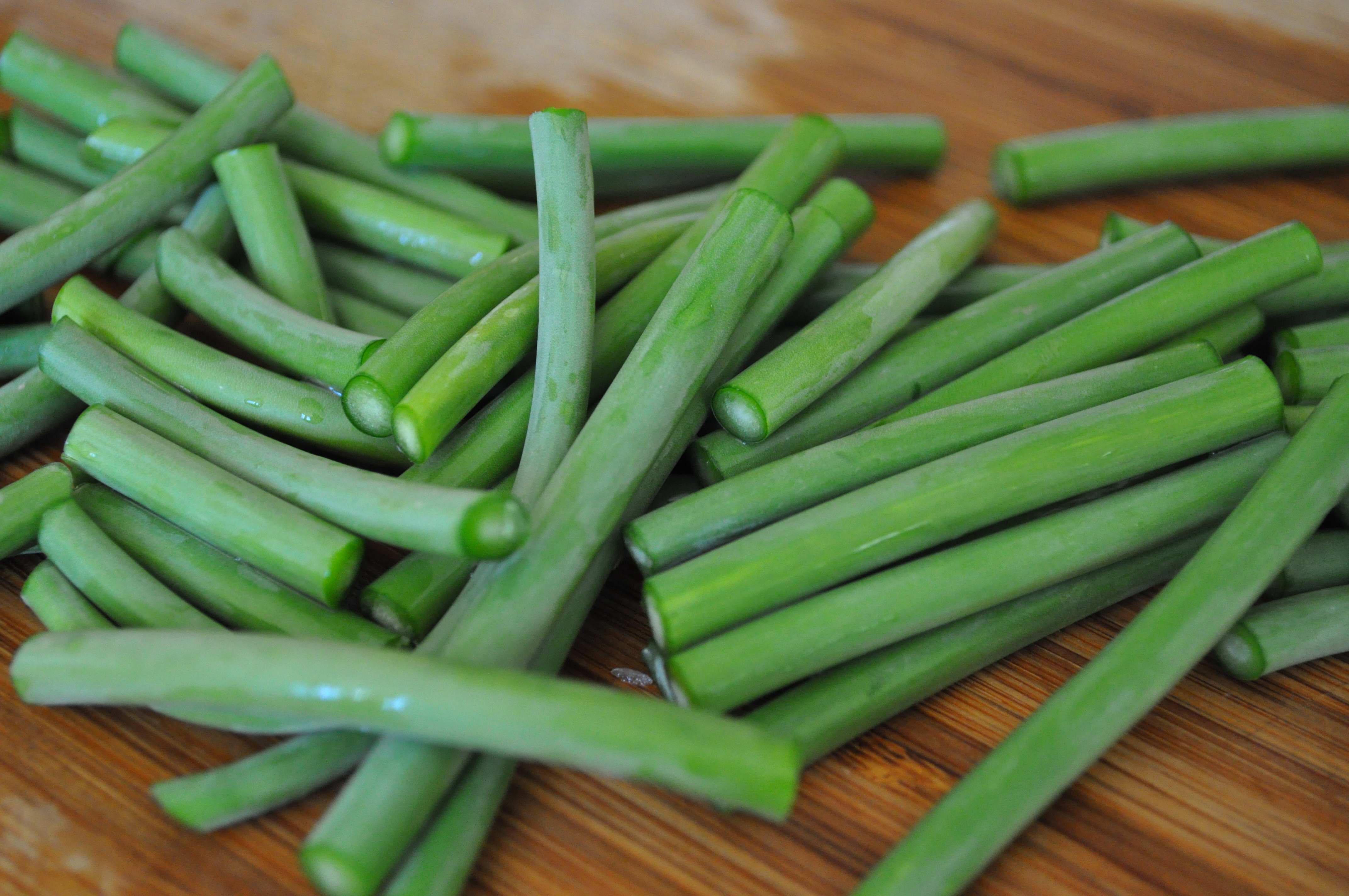
2. Get a glass jar or container, add the cut scapes and garlic cloves and pour the hot soy sauce+vinegar+ sugar mixture:
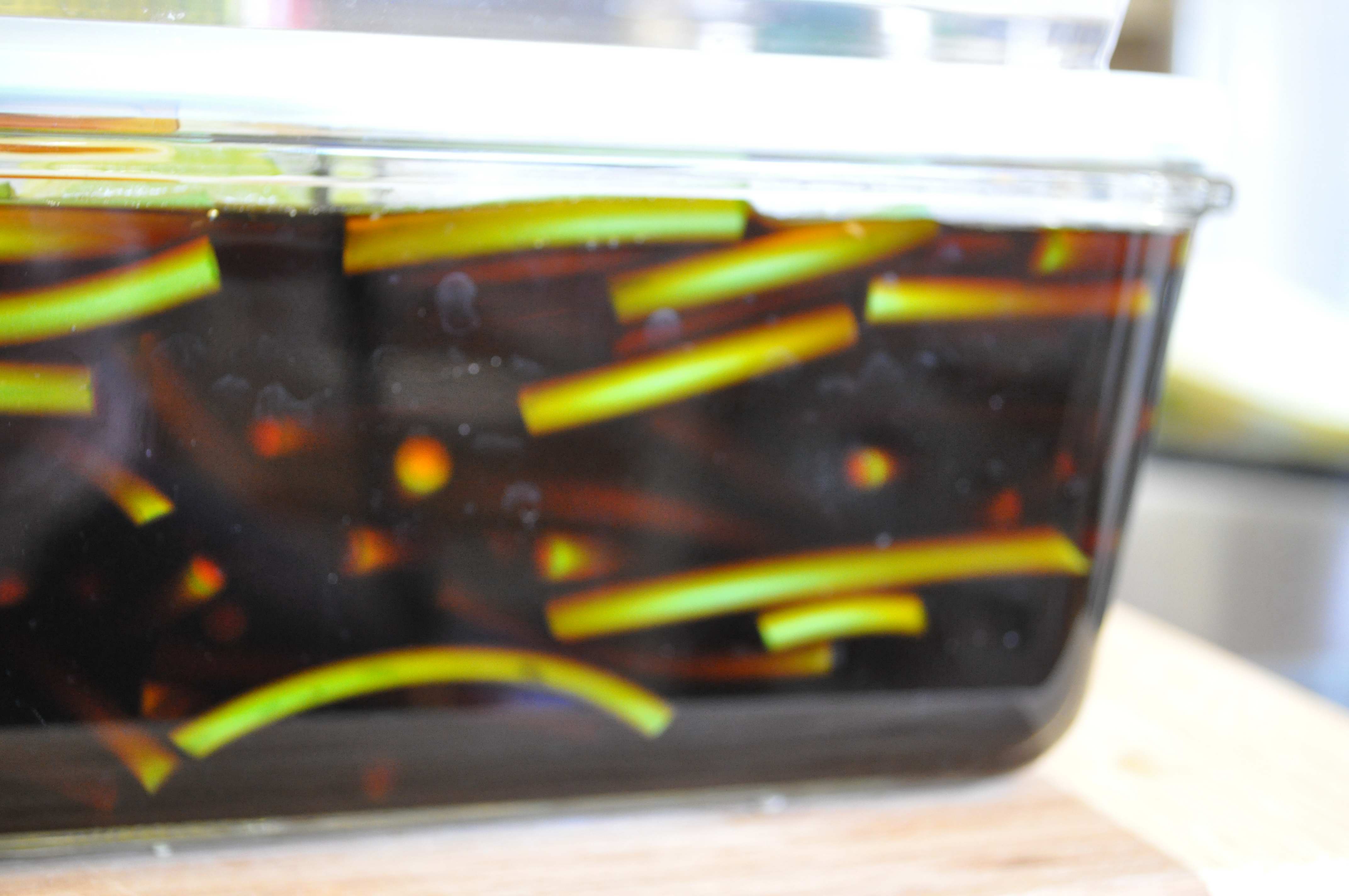
3. After 3 days, drain the liquid, boil it and add it back. Leave it for 4 more days.
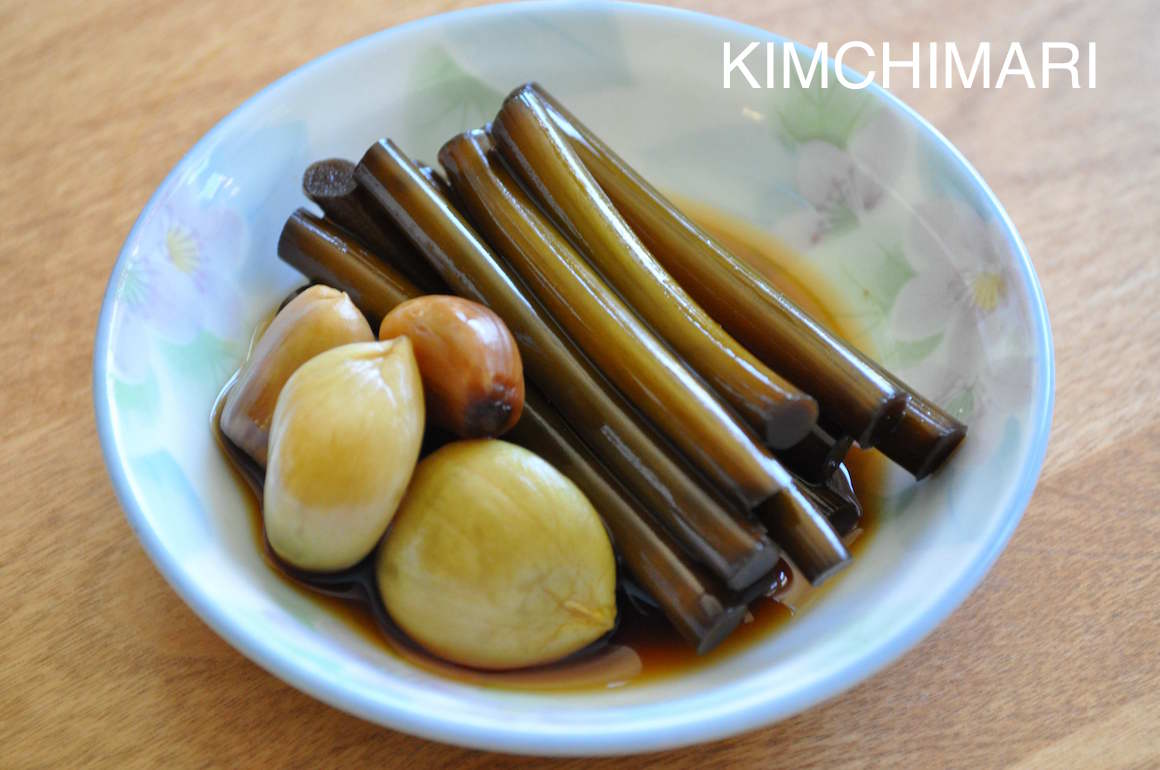
This is how it looks after a week! You have to try this – the garlic scape has such a beautiful delicate garlic flavor with a perfect crunch in every bite.

Korean Pickles (Jangajji)
Ingredients
- 4 Korean cucumbers (오이 Oyi) (Persian or Pickle cucumbers also OK)
- 5 green chili peppers (optional)
- 3 C soy sauce (approx.)
- 3 C sugar (approx.)
- 3 C rice vinegar (approx.)
- 1 handful of rough sea salt
Instructions
- Mix soy sauce, vinegar and sugar in a pot and let it come to a boil. When it boils, turn the heat off and let it sit.
- In the mean time, grab a generous pinch of sea salt and clean the cucumbers by rubbing each one with salt.
- Rinse cucumbers with water and pat them dry. You can then cut the cucumbers into bite size pieces or keep them whole.
- Wash green chili peppers. Whole peppers can be used or can be cut into pieces. When using whole peppers, make a hole in the pepper by piercing it with a sharp skewer or toothpick. If you cannot find Korean chili peppers, you can also use Jalapeno peppers or other peppers. A good substitute for a Korean chili pepper is the Anaheim green chili pepper.
- Put both cucumbers and chili peppers into the jar. Pour soy sauce mixture onto the vegetables. The sauce should be quite hot – the hot temperature of the sauce shocks the vegetables and makes them crunchy so make sure it’s nice and hot!
- Find something to weigh the vegetables down and you are almost done!
- Let it sit for 3 days in room temperature and then drain the liquid out, boil it and then add it back to the jar while it is still hot. Leave it for 4 more days.
Tips for Korean Pickles
* Serving: you can just serve as is or sprinkle some roasted sesame seeds on top. You can also add some seasoning such as sesame oil, red chili powder and chopped fresh green onion.
* Storage: you can store these Korean pickles at room temperature for weeks without the taste changing at all. No fridges in the old days.
* Taste: adjust the amount of vinegar and sugar to taste. I have seen recipes which uses less vinegar and sugar (1/3 of amount used here). I personally prefer the 1:1:1 ratio since these are meant to be sweet and sour.
* What do you do with the leftover Korean pickle juice? : make more pickles by just getting more vegetables and then re-boiling the juice before making a new batch. The soy sauce mixture does seem to become less salty with the water coming out from the vegetables during the pickling process so you may want to add additional soy sauce mixture to bring up the level of salt.
Happy Summer!
XOXO ❤️
JinJoo

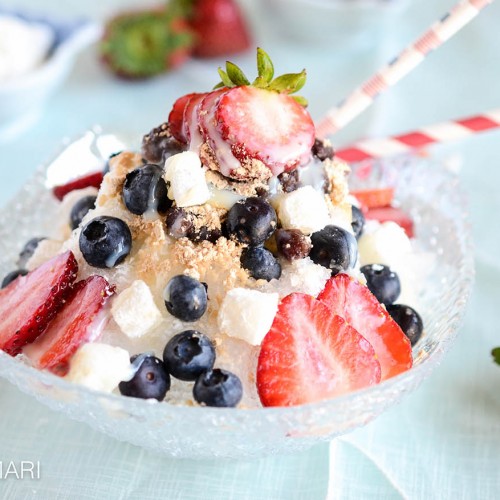
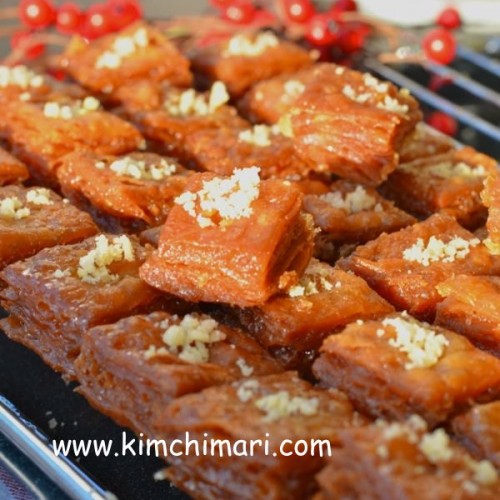
















Is this recipe ment to be left on the counter or stored in the fridge?
It’s meant to be left on the counter. It will not go bad as long as you follow my recipe. Good luck!
Hi! By the time i poured the sauce it was warm not hot and I hust poured it like that. Is it okay?
Well, the cucumbers may not be as crunchy and you will not have the vacuum so it may not stay unspoiled for long. You could refrigerate to keep it fresh. or you could just pour out the juice, boil it and pour it back when HOT after 2-3 days. Hope that helps. Good luck!
can you can the garlic scapes in this recipe for longer storage ?
Hi Judy – are you asking if you can ‘can’ the garlic scapes for longer storage? I don’t think why not? They should keep well for months to a year. Good luck!
Hi JinJoo! I noticed the recipe for the garlic scapes and garlic, were separate from the cucumbers and peppers. Can I combine them all and use the 1:1:1 ratio for everything?
Love your recipes! Thank you for sharing them all!
Oh yes, you can totally combine them together. Thank you so much and good luck!!
Wow! You answered in lightning speed, Thank you so much! 😊 I got lucky with finding garlic scapes at the Korean Market over a week ago, and know they need to be used. Recipe is on my to-do list tomorrow
Sorry for this late reply. 🙂 I was away for the weekend. Garlic scapes are my favorite to make pickles with – enjoy with BBQ and as everyday banchan!
This tastes just like my late grandma’s jangahchi. I haven’t had this taste in over a decade. Thank you so much for sharing. Also I love celery so I added a bunch with 2 bunches of garlic scapes. I made a few batches now. Hopefully it’ll last me till next spring when the garlic scapes are back.
Awww.. that always makes me so happy to hear!! Sure, celery, broccoli stems, jicama, radish, all work great. Thank you so much!